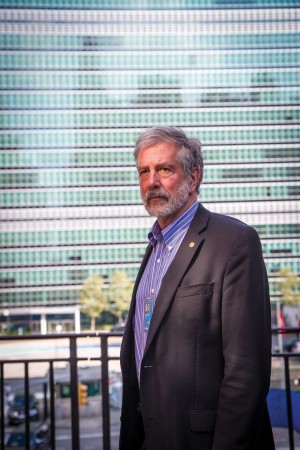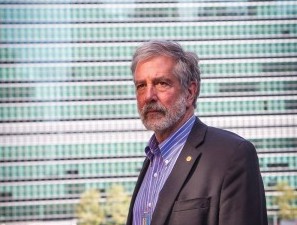Bishop Marc Stenger, co-president of Pax Christi International, celebrates the 2020 feast of the Assumption of Mary in Kevelaer. In his sermons, he reflects on the importance of Kevelaer for the beginnings of the Pax Christi International movement. The town of Kevelaer’s special bond with the Pax Christi International movement has its origins in 1948, when the first Pax Christi congress on German soil took place in Kevelaer. The bridge-builder of peace was the Bishop of Lourdes, Pierre Marie Theas, who began his welcoming speech with the words: “I greet the whole of Germany and bring it the brotherly kiss of Christian France, a kiss that grants forgiveness and seeks such, that is: the kiss of reconciliation.”
PREDIGT
Liebe Pilgerinnen,
Liebe Pilger,
Das Leitwort für die Wallfahrt 2020 ist gerade in der Zeit der Covidpandemie, die immer noch unseren Alltag prägt, ein Wort der Ermutigung : « Ich bin, da wo du bist », nach dem Philosoph, Martin Buber, der so die Worte Gottes an Mosè (Exodus 3, 14) übersetzt, also eine Zusage, die auch heute Christen Trost und Kraft schenkt. In diesem Jahre kann die Wallfahrt zu der als « Trösterin der Betrübten » verehrten Gottesmutter nicht ganz wie sonst erlebt werden : weniger Leute, berufliche Ängste,, schwierige menschliche Situationen, und auch strengere Regeln für das Sammeln. Aus diesem Grund wollen wir umso mehr unser Vertrauen auf die Gottesmutter legen und Ihr unsere Menschheit, die Hoffnung braucht, anvertrauen.
In einem seiner Bücher schrieb Martin Buber: « Zu jeder Zeit ruft Gott jedem Menschen zu : Wo bist du in deiner Welt ? Von denen, die dir zugeschrieben werden, sind so viele Tage vergangen und so viele Jahre. Wie weit bist du. Bis wo bist du in der Zwischenzeit in deiner Welt gekommen ?
Wenn Gott solche Fragen stellt, geht es ihm nicht darum dass der Mensch ihm etwas erzählt, das er noch nicht wissen würde. Er will im Menschen etwas provozieren, er möchte ihm in Herzen berühren und ihm bewusst machen, dass er den Austausch mit ihm sucht.
Schon im Garten Eden, im Buch des Genesis, fragt Gott Adam : Wo bist du ? Er weiss, dass Adam sich versteckt, um die Entscheidung, die verbotene Frucht zu essen, nicht rechtfertigen zu müssen, um der Verantwortung für sein Leben zu entgehen. Er versteckt sich nicht nur vor Gott, , er versteckt sich vor* sich selbst. Mit anderen Worten, er sieht seinem Leben nicht ins Gesicht, er rutscht weg, er bleibt stecken. Er berücksichtigt sein Leben, seine Geschichte nicht vollständig. Um das zu tun sollte er, wo er angekommen ist, die Stimme Gottes, die Gegenwart Gottes erkennen, die ihn befragt, der zu ihm sagt : Wo du bist, bin ich… um dich aus deiner Sackgasse herauszubringen.
So gross die Freude eines Menschen über beruflichen oder privaten Erfolg, so bedeutend seine Macht, wie kolossal das Werk seines Lebens auch sein mag, all das kann Ihn nicht auf den richtigen Weg bringen, wenn er in seinem Leben und in seinem Leisten die Stimme Gottes, die ihn ruft befragt und leitet, nicht erkennt. Adam steht vor der Stimme Gottes, er erkennt die Stagnation, er gibt zu : « Ich habe mich versteckt » und dort beginnt für ihn ein neuer Weg des Menschseins
Die Jungfrau Maria ist das genaue Gegenteil Adams. Sie weiss und nimmt mit Freude an, dass Gott Teil Ihres Lebens ist, wie des Lebens eines jeden Menschen. Sie versucht nicht davon abzuweichen. Im Gegenteil, sie dankt für alle die Wunder, die er vollbringt, und wenn ihm durch die Vermittlung des Engels die aussergewöhnliche Mission anvertraut wird, Mutter des Sohnes Gottes zu werden, ist ihr Vertrauen in diesen Gott , der das Wohl jedes Mensch will und ihn auf seinem Weg begleitet, absolut.
In Maria können wir also entdecken, was der Mensch im Gottesplan ist. Die Menschen wissen nicht, was der Mensch ist, so verschieden sind die philosophischen und religiösen Vorstellungen. Wir Christen können es wissen. Gott sagt es uns. Was ist der Mensch ? Ecce Maria -seht Maria : das ist der Mensch, der Euch gegeben ist, damit ihr ihn nachahmt. Liebe Pilgerinnen und Pilger, In Maria ist alles ausgedrückt, was Gott über den Menschen denkt und plant. Sie ist der vorbildlicher Mensch., weil überall da, wo Sie ist, Gott in Ihrem Leben ist. Gewiss ist auch schon Jesus Christus in höchster Potenz das Vorbild aller Menschen, er ist aber mehr als Mensch. Er ist der Erlöser der Menschen. Aber Maria ist wie wir Erlöste. Wenn auch vor erlöst, weil Ihr ja die Erbsünde erspart blieb, aber sie ist eine Erlöste und deswegen steht Sie uns ganz nahe, sowie Gott Ihr anz nahe steht. Und deswegen können wir bei Ihr Christus spüren.
So sehen wir die Wahrheit unseres Lebens in der Aufnahme Mariens in den Himmel ausgedrückt. Sie gibt uns Zuversicht und Mut, weil wir wissen dadurch, es ist nicht zu Ende , wenn unser Leib zerfällt. Es gibt ein anderes Leben und Gott hat uns eine Wohnung bereitet, in die wir eingehen dürfen. Das ist die Grösse und die Würde des Menschen. Was uns durch Maria gesagt wird ist, dass Gott den Dialog den er mit den Menschen einmal begonnen hat, nie mehr abbricht. Diese Würde hat der Mensch sich nicht selbst erobert, erworben, erarbeitetwird ihm geschenkt. In Maria heisst : ich bin, wo du bist, : « Grosses hat er an mir getan, der Allmächtige. » Und Grosses will er an uns tun, wenn wir nach dem Beispiel Mariens leben, wenn wir unser Leben in der Treue zu Gott und in der Ergebenheit gegenüber Gott verbringen. Weil Maria die demütig Empfangende war, wurde sie zur Vollendung geführt. Das Beste, das Höchste,, das Unvergängliche wird uns nicht durch unserer Hände Arbeit erworben, wie Adam es meinte, sondern es wird uns von Gott geschenkt. Und der Mensch kann nur Mensch bleiben, wenn er sich von der Gnade führen und über seinen eigenen Grenzen hinwegtragen lässt.
Ein wesentlicher Punkt des Dogmas der Aufnahme Mariens in den Himmel mit Leib und Seele, ist , dass « Ich bin wo du bist », nicht nur die Würde der Seele, sondern auch des Leibes bedeutet. Der Leib. mit allem was dazugehört hat seine Würde von Gott. Gott hat den Leib geschaffen, und er hat Ihn uns geliehen, damit wir in ihm unser Heil und das Heil der Menschheit wirken , und er will diesen Leib verherrlichen. Maria, Gottesmutter und Gottesgebärerin, hat auch leiblich reagiert. In ihrem Leben hat sie auch vieles ertragen und gelitten. In Ihr begreifen wir auch besser, um was es geht mit dem Leib, der nicht nur die Hülle der Seele ist, sondern seine eigene Würde im Plan Gottes hat. Der Leib ist so zu sagen das Werkzeug, mit dem wir die Welt gestalten sollen.. Mit unserem Leib sollen wir wirken , Güter schaffen, Anderen helfen, die Erde bebauen und auf dieser Weise zur Verherrlichung Gottes beitragen. Der Leib ist auch ein Ort des Ausdrucks der Schönheit, zum Beispiel der spörtlichen Entwicklung. Der Leib vermittelt auch die Begegnung der Körper und die Vermehrung der Menschheit. Abhängig von der Beziehung, die wir zum Körper haben können wir aber auch dem umgekehrten Weg der Verherrlischung folgen. Mit Mariens Aufnahme im Himmel mit Leib und Seele lässt Gott uns die unendliche Würde des menschlichen Leibes erkennen. Diese Würde wie keine anders ist nur richtig zu verstehen, wenn man sie mit der Lehre der unbefleckten Empfängnis verbindet. Der Leib Mariens, Gottesmutter, war von Anfang an vor Sünde bewahrt und dieser Leib, der nie in das Verhängnis der Erbsünde hineingezogen war, sollte nicht der Verwesung überliefert werden.
Maria spiegelt die Berufung unseres eigenen Leibes. In dieser Zeit der Covid-19 Pandemie haben wir uns alle gewünscht, auf uns selbst aufzupassen . Dass gilt nicht nur für unsere Gesundheit ; es ist auch ein Aufruf diesen Leib zu respektieren und zu verehren.
Durch Maria verkündet die Kiche, dass der Mensch mit Leib und Seele fähig ist zur Aufnahme in der Herrlichkeit Gottes. Das kann aber nicht ohne Erkennung des grossen Wertes des Leibes geschehen. Der Mensch hat so tiefe Würde, das sie nicht zerstört werden kann, selbst wenn menschliche Bosheit das tut und immer wieder neu versucht. Die Botschaft der Aufnahme Marien in den Himmel ist das Gegenzeichen ! Ein grossen Zeichen gegen alle Grausamkeiten die bis zur Stunde menschlichem Leben angetan werden. Übertragen wir das bis in unser Leben und in unserer Gegenwart hinein, dann dürfen wir fragen : « Bin ich mir selbst meiner Würde als Mensch bewusst, welche Kosbarkeit mein Leib ist »
Danke der Gottesmutter, die uns den Preis unseres Menscseins mit Leib und Seele gezeigt hat. Sie ist so zu sagen der Gotteswegweiser zur unsere Verherrlichung als Vermittlerin seines Rufes : Wo bis du ? heute in Kevelaer und jeden Tag.
Kevelaer, 15. August 2020
Marc Stenger
EINFUHRUNG
Es ist eine besondere Ehre und eine grosse Freude für mich, am 15. August, an diesem aussergewöhnlichen Ort der Basilika von Kevelaer die Eucharistie zu zelebrieren. Dieser Ort ist für mich, als Präsident von Präsident von Pax Christi Frankreich und jetzt Co-Präsident von Pax Christi International, ein Stammort, ein Quellort. Er verkörpert den Willen zweier Völker, das deutsche und das französische – und von da ab noch viel mehr – einander zu vergeben, sich zu versöhnen, einander zu lieben, und für das Gemeinwohl der Menschheit zusammenzuarbeiten, wo Hass, Spaltung, Gewalt und Vernichtung der menschlichen Person solange vorherrschten.
In Kevelaer fand 1948, drei Jahre nach dem Ende des zweiten Weltkrieges, in dem so schrecklichen Vergehen erlebt worden sind, der erste internationale Kongress von Pax Christi statt, auf dem Bischof Theas, der Ursprung von Pax Christi war, diesen denkwürdigen Satz von grosser historischer Bedeutung sagte : « Ich grüsse das versammelte Deutschland und bringe ihr den brüderlichen Kuss aus dem christlichen Frankreich, ein Kuss der Vergebung gibt und um Vergebung bittet, der Kuss der Versöhnung genannt wird. »
In Erinnerung an diese für die Völkerverständigung so beteudende Begebenheit ligt in der Mitte dieses Wallfahrtortes eine Pax Christi Kapelle, deren Altar im 1982 geweiht wurde, und in derer Raum sich das Eigentum des Pax Christi Forum, Ort der Begegnung, des Gebetes und des Nachdenkens über die Zukunft unserer Gesellschart. Sie Könnent, vermute ich, gut verstehen, dass meine eigene Pilgerfahrt auch durch diese symbolischen und geistliche Orte hindurchgehen wird.
Sowieso hier in Kevelaer kommen wir, um zu Maria zu beten, die Trösterin der Betrübten. Maria liess sich im Dienst von Gottes Pläne für die Menschheit. Noch immer wollte Er die Rettung der Menschen. Heute haben wir so sehr Gründe uns Sorgen zu machen, als wir immer noch in den unsicheren Zeiten einer anhaltenden Pandemie stehen, als Gewalt, Unterdrückung der Schwachen, Katastrophen, Rassismus und Ausgrenzung immer mehr zunehmen. In diesr Zeit sendet uns aber die Gottesmutter eine grossartige Botschaft von Ihm :
« Ich bin, wo du bist »
In deinen Situationen der Trostlosigkeit und des Zorns, in denen du lebst, bin ich da, um dich zu erheben und mit meiner Kraft zu füllen. Grosse, heute notwendige Ermutigung, die wir von Gott durch die Jungfrau Maria. Môge diese Botschaft das geistliche stichwort unseres gesamten Pilgerreise sein.
Marc Stenger
Photo: Gerard Stoke via Flickr (CC BY-NC 2.0)









